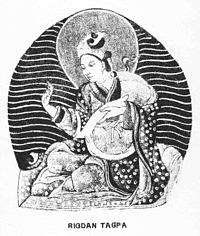Naropa University

President Charles G. Lief | | |
Academic staff | 164 | |
|---|---|---|
| Undergraduates | 402 | |
| Postgraduates | 617 | |
| Location | , , United States | |
| Campus | Midsize City, 12 acres (0.049 km2) | |
| Colors | Heather Purple[2] | |
| Nickname | Bodhi Cheetahs[2] | |
| Website | www | |
| Part of a series on |
| Shambhala Buddhism |
|---|
 |
Naropa University is a
Naropa was accredited by the
History
Naropa University was founded by Chögyam Trungpa, an exiled Tibetan tulku who was a Karma Kagyu and Nyingma lineage holder. Trungpa entered the USA in 1970, established the Vajradhatu organization in 1973, and then in 1974, established Naropa Institute under the Nalanda Foundation.[3] Initially, the Nalanda Foundation and Vajradhatu were closely linked, having nearly identical boards of directors. In subsequent years they differentiated into more independent institutions.[4]
Trungpa asked poets
Naropa's first formal degree programs were offered in 1975–76. These included a BA in Buddhist studies and visual art, MA in psychology, MFA in visual art, and expressive arts certificates in dance, theater, and poetics.[citation needed]
The MA in psychology was originally designed as an extension of Trungpa's Maitri program, a 16-week meditation course held in Connecticut, and based on Vajrayana teachings on esoteric energy patterns within the mind and body. Trungpa asked Marvin Casper to restructure the Maitri program for use at Naropa as a full-fledged graduate degree program in contemplative psychotherapy. Casper went on to chair that department and edit two of Trungpa’s books. Initially for the degree, students were required to attend three of the institute’s summer sessions, take two Maitri programs in Connecticut, and complete a six-month independent project.[citation needed]
In 1977, at Trungpa's urging, Naropa's administration made the decision to seek regional accreditation. Evaluation visits continued through 1986, and in 1988, Naropa Institute received accreditation from the
In 1991 Naropa's board of trustees hired John Cobb, a Harvard-educated lawyer and practicing Buddhist, as president.[6] Thomas B. Coburn served in this role from 2003 to 2009, succeeded by Stuart C. Lord in July 2009.[citation needed]
The university began engaging in
Spiritual principles
Naropa promotes contemplative education – a term used primarily by teachers associated with Naropa University or
- Geoffrey Samuel, Rimé movement in Eastern Tibet... When Naropa describes itself as a Buddhist-inspired, nonsectarian liberal arts college, "nonsectarian" translating to the Tibetan rimed. Nonsectarian does not, however, mean secular as it is commonly used in higher education. Nonsectarian is perhaps understood as ecumenical openness to contemplative practices and arts of the world religious traditions that foster precision, gentleness, and, spontaneity.[8]
Goss goes on to note that as with many U.S. Protestant and Catholic colleges and universities, Naropa has faced pressure to establish independence from its associated religious organization, Shambhala International; but unlike many such institutions, it has avoided relegating religion to the periphery of university life.[9]
Naropa's description of contemplative education makes liberal use of Buddhist language and concepts. For example, its catalogue speaks of "students wholeheartedly engag[ing] in mindfulness awareness practices in order to cultivate being present in the moment"..."the development of openness, self-awareness, and insight"...and "interior work" as "preparation for compassionate and transformative work in the world."[10]
Notable alumni
- Gregory Alan Isakov[11]
- Brenda Coultas[12]
- Bunky Echo-Hawk[13]
- Justine Frischmann[14]
- Tim Z. Hernandez[15]
- Jonathan Siegrist[16]
- Cedar Sigo[17]
- Eleni Sikelianos[18]
- Brad Will[19]
See also
References
- ^ "Data USA - Naropa University".
- ^ a b "Naropa University".
- ^ Hayward (2008), pp. 91–93.
- ^ a b Goss (2013), p. 220.
- New York Times. November 4, 2007. Retrieved March 5, 2013.
- ^ Goss (2013), p. 221.
- Boulder Daily Camera. Retrieved May 17, 2019.
- ^ Goss (2013), pp. 218–219.
- ^ Goss (2013), pp. 229ff.
- ^ "Contemplative Education: The Spark of East and West Working Within". Naropa University. Archived from the original on 2012-06-10.
- ISSN 0362-4331. Retrieved 2020-03-31.
- ^ Poets, Academy of American. "About Brenda Coultas | Academy of American Poets". poets.org. Retrieved 2020-03-31.
- ^ Rice, Almah LaVon (October 3, 2007). "Wily, Witty and Whimsical". www.colorlines.com. Retrieved 2020-03-31.
- ISSN 0261-3077. Retrieved 2020-03-31.
- ^ "Tim Z. Hernandez". Poets & Writers. July 1, 2012. Retrieved 2020-03-31.
- ^ Miller, Leah (May 30, 2012). "Q & A with Jonathan Siegrist". Climbing. Retrieved July 18, 2023.
- ^ Mishler, Peter (January 11, 2019). "Cedar Sigo on Playfulness and Poetry". Literary Hub. Retrieved 2020-03-31.
- ^ Sikelianos, Eleni. "Eleni Sikelianos Biography". Poem Hunter. Retrieved 2020-03-31.
- ^ Berrigan, Edmund (March 31, 2020). "Visiting Naropa in the Summer of 1992". Poetry Foundation. Retrieved 2020-03-31.
Works cited
- Goss, Robert E. (2013). "Buddhist Studies at Naropa: Sectarian or Academic?". In Queen, C.; Williams, D. R. (eds.). American Buddhism: Methods and Findings in Recent Scholarship. Taylor & Francis. pp. 215–237. ISBN 978-1-136-83033-4.
- Hayward, Jeremy (2008). Warrior-King of Shambhala: Remembering Chögyam Trungpa. Wisdom Publications. ISBN 978-0-86171-546-6.
Further reading
- ISBN 0-932274-06-4.
- Kashner, Sam (2004). ISBN 0-06-000566-1.
- Marin, Peter (February 1979). "Spiritual Obedience: The Transcendental Game of Follow the Leader". Harpers Magazine.
